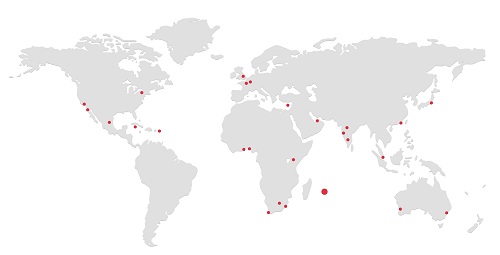Jan 2, 2022 by Arun vats
80% ENTERPRISES HAVE DEVELOPED THEIR CHOICE.
Automation software is must for today’s enterprise. Robotic Process Automation (RPA) is that the technology that enables anyone nowadays to configure system software

Jan 2, 2022 by Arun vats
Automation software is must for today’s enterprise. Robotic Process Automation (RPA) is that the technology that enables anyone nowadays to configure system software
Robotics process automation(rpa) allows organizations to automate task just like a human being was doing them across application and systems. Robotic automation interacts with the existing it architecture with no complex system integration required.
Rpa can be used to automate workflow, infrastructure, back office process which are labor intensive. These software bots can interact with an in-house application, website, user portal, etc. The rpa is a software program which runs on an end user’s pc, laptop or mobile device. It is a sequence of commands which are executed by bots under some defined set of business rules.
The main goal of robotics automation process to replace repetitive and boring clerical task performed by humans, with a virtual workforce. Rpa does not require the development of code, nor does it require direct access to the code or database of the applications.
Business
Strategy
Online
Marketing
Consumer
Products
Introducing Super Web Development LLP – Your Partner in Success!
Our team of expert developers, designers, and SEO specialists are here to take your business to the next level. With our cutting-edge SEO services, we’ll fine-tune your website to perfection, ensuring that it ranks higher on search engines.
We’re seeing growing interest and investment in AI-related technology by Fortune 100 companies in almost every industry. In financial services, for example, robo-advisors, intelligent underwriting and automated agent-based banking services are already in action. However, the multitude of options notwithstanding, adopters are being confronted with some tough decisions in their journey to enterprise AI, including:
Manufacturing: Robotic arms and machines are extensively used in manufacturing industries for tasks such as assembly, welding, painting, and packaging. These robots can perform repetitive and precise tasks with high efficiency, speed, and accuracy.
Warehousing and Logistics: Robotic automation is employed in warehouses and distribution centers for tasks like sorting, picking, and placing items. Autonomous mobile robots (AMRs) are used to transport goods within the facility, optimizing inventory management and reducing manual labor.
Healthcare: Robots are utilized in healthcare settings for various purposes, including surgery, rehabilitation, and patient care. Surgical robots assist surgeons in performing minimally invasive procedures with enhanced precision and control. Robotic exoskeletons[1] aid in physical therapy and rehabilitation of patients with mobility impairments.
Agriculture: Agricultural robots, also known as agribots or agri-robots, are used in farming operations. They can perform tasks such as planting seeds, harvesting crops, monitoring crop health, and applying pesticides. These robots help increase productivity, reduce labor costs, and optimize resource utilization.
Customer Service: Robotic automation is employed in customer service to handle repetitive and routine tasks. Chatbots and virtual assistants, powered by artificial intelligence, can interact with customers, provide information, answer queries, and assist with basic transactions, freeing up human agents to handle more complex issues.
Mining and Exploration: Robots are utilized in mining operations for tasks that involve hazardous or inaccessible environments. They can perform activities like drilling, excavation, and transportation of materials. In space exploration, robots are used for planetary rovers to collect data and conduct experiments.
Home Automation: Robotic automation is becoming increasingly common in households. Robotic vacuum cleaners, such as Roomba, automate the process of cleaning floors. Smart home devices and personal assistants, like Amazon Echo or Google Home, integrate voice commands and automation to control various home functions, such as lighting, temperature, and security.
This highlight the diverse applications of robotic automation across different industries and sectors. The use of robots improves efficiency, productivity, safety, and can lead to cost savings in various domains.
AI is a rapidly maturing and fast-changing field, and if you tie yourself to a single vendor, you run the risk of technological obsolescence.
Software-as-a-service end-points can be opaque and inflexible, it can be challenging to customize AI solutions/ modules to business needs.
Vendor offerings, which are often limited in business application, can be expensive (proof-of-concept work for some applications can cost at least $1 million).
The latest AI technology, such as deep learning, is growing in sophistication at a rapid pace, meaning businesses must be consistently ahead of the curve to exploit the potential.
| 1. Website scraping | 11. Generating renewal premiums | 21. Underwriting processes |
| 2 . Customer Order Processing | 12. Client profile updates | 22. Policy administration and servicing |
| 3. Incoming Customer email query processing | 13. Forms processing | 23. Requests for overdraft protection |
| 4. Transferring data from one system to another | 14. Claims processing | 24. Underwriting processes |
| 5. Call center operations | 15. Payroll processing | 25. Policy administration and servicing |
| 6. Policy administration and servicing | 16. Requests for overdraft protection | 26. Exception processing |
| 7. Straight-through processing of customer orders | 17. Order updates | 27. Shipping notifications |
| 8. Customer complaints processing | 18. Data cleansing | 28. Fraudulent account closing |
| 9. Benefits administration | 19. W4 management | 29. Credit card applications< |
| 10. Member eligibility and billing | 20. Patient registration | 30. Dispute resolution |
Robotic Process Automation is well suited for processes that are clearly defined and well documented, repeatable without much changes and also if they are rules based. Based on criteria mentioned, it helps organizations across numerous industries automate the completion of a wide variety of tasks.
Planning
Next, steps in planning phase are
Development
Testing
Support & Maintenance
1. Emulates Human Action: Emulates human execution of the repetitive process using various application and systems.
2. Conduct high-volume repeated tasks: Robotics process automation can easily simulate rekeying of data from one system to another. It performs tasks like data entry, copying, and pasting.
3. Perform Multiple Tasks: Operates multiple and complex tasks across multiple systems. This helps to process transactions, manipulate data and send reports.
4. ‘Virtual’ system integration: This automation system can transfer data between disparate and legacy systems by connecting them at the user interface level instead of developing new data infrastructure.
5. Automated report generation: Automates the extraction of data to comes up with accurate, effective and timely reports.
6. Information validation and auditing: Resolves and cross-verify data between different systems to validate and check information to provide compliance and auditing outputs.
7. Technical debt management: Helps to reduce technical debt by reducing the gap between systems, preventing the introduction of custom implementations.
8. Product management: It helps to bridge the gap between IT systems and related product management platforms by automated updating of both systems.
9. Quality Assurance: It can be beneficial to QA processes which cover regression testing and automating customer use case scenarios.
10. Data migration: Allows automated data migration through systems which is not possible using traditional mediums, like document, spreadsheets or other source data files.
11. Gap solutions: Robotic automatic fills the gaps with process deficiencies. It includes may simple tasks as password resets, the system resets, etc.
12. Revenue forecasting: Automatically updating financial statements to predict revenue forecasting.

Blue Prism is a Robotic Process Automation software. It provides businesses and organizations with an agile digital workforce.

Automation Anywhere is a developer of robotic process automation (RPA) software.

UiPath is Robotic Process Automation software. It helps organizations efficiently automate business processes.
| Industry | Usage | Live Project |
|---|---|---|
| Healthcare | Patient registration, Stock, Billing | WDG Healthcare; WDG Pharmacy |
| HR | Employee joining, Payroll process, Hiring | WDG Payroll, WDG Employee |
| Education | Fee Management, Attendance, Payroll, Visitors | WDG School |
| Insurance | Claims Processing & Clearance, Premium Information | Start Soon |
| Manufacturing & Retail | Bills of material, Calculation of Sales | WDG POS, WDG Retail |
| Telecom | Service Order Management, Quality Reporting | Call Center System |
| Travel & Logistic | Ticket booking, Passenger Details, Accounting | Start Soon |
| Banking & Finance | Cards activation, Frauds claims, Discovery | NA |
| Government | Change of Address, License Renewal | NA |
| Infrastructure | Issues Processing, Account setup and communication | WDG Rent |
| 1 | SINGAPORE | REPUBLIC OF KOREA | 93.23% |
| 2 | JAPAN | GERMANY | 80.43% |
| 3 | SWEDEN | DENMARK | 70.35% |
| 4 | ITALY, BELGIUM | USA | 67.87% |
| 5 | TAIWAN | UNITED KINGDOM | 65.94% |
| 6 | CANADA | FRANCE | 64.34% |

Robot density is a measurement that tracks the number of robots per 10,000 workers in an industry. This shows more countries are turning to automation to fill their manufacturing needs.
It is not necessary for IT teams to change any existing systems for an RPA solution. RPA software can non-invasively interact with target applications through same user interface utilized by humans. Leading RPA software tools can interact with most major mainstream and legacy thin and thick client applications based in Java, Mainframe, Web, and Windows. If the robots were run off-premises, IT team would need to grant robots with system access as they would do with a new employee and keep the underlying applications running.
Robots simulate end-user interaction with networks and target applications. If networks and target applications are unavailable it will impact a process but alerts can be set to immediately flag internal staff. Well designed will maintain the integrity of the work queue when faced with an unanticipated application or network performance breakdown.
Leading automation solutions have native multi-level, configurable, auditable logs in addition to reporting and alerting features. These allow organizations to meet or exceed their industry-specific regulatory requirements including SOX, HIPAA, and PCI DSS.
Yes — leading RPA tools provide global and customizable dashboards, audit logs, and management information reports and features for enhanced visibility and monitoring.
Why we are different? Super Web Development LLP brings together digital innovation Architecture and Technology with the best business ideas. Don’t follow Digital Trends.. Start them.
Don’t miss out on thousands of super cool packages and promotions
HOTLINE: +91 9873 161 789
(Free Call, 8:00 – 22:00)
B11 3rd-Floor, Sector 121,
Noida, india 201301

